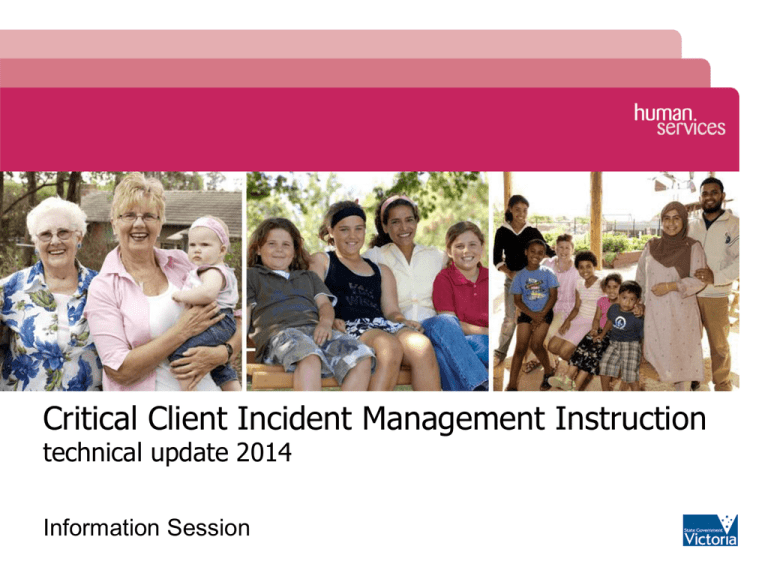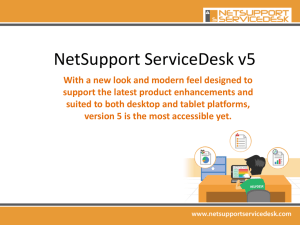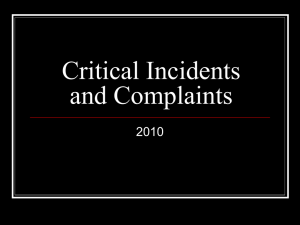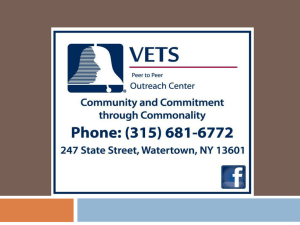
Critical Client Incident Management Instruction
technical update 2014
Information Session
Purpose of today’s session
Overview of Critical Client Incident Management Instruction
technical update 2014
•
Define client incident reporting – what it is and why we
do it.
•
Provide an overview of the incident management and
reporting requirements, including when a client incident
report is required.
•
Explain incident types and categories.
•
Demonstrate how to complete the Client Incident Report
form.
•
Illustrate how we can learn and improve our service
delivery through good incident reporting and analysis.
2
The benefit of reporting critical client incidents
Reporting critical client incidents is an important part of
quality improvement and safety.
The key reason for reporting incidents is to learn from them
and, if possible, prevent their repetition.
3
Without a detailed analysis
of incidents and near
misses, we may fail to
uncover problems that are
potential hazards to clients
and staff.
4
Who is in scope for the Critical client incident
management instruction?
Refer to Section 2 Scope of the instruction (pp. 2,3 and 4,)
Category
Program
1
2
Disability Services
X
X
Out of Home Care (CYF)
X
X
Youth Services and Youth Justice
X
X
Housing & Community Building
X
X
Housing & Community Building: Crisis Accommodation Services and
Crisis Support Services
X
Family Services and Child FIRST
X
Family Violence/Sexual Assault Services
X
5
When is a client incident report required?
A client incident report is required for all critical incidents
that occur at the service or during service delivery which
involve and/or impact upon clients.
This includes all critical incidents that occur:
•
while a staff member is with the client
•
when the client attends a service provider’s premises,
including offices, residential services, respite facilities or
day services
•
when a staff member is providing in-home support or
support in the community with the client
•
onsite at the service, including inside and around the
building and locations that are within view of staff
6
When is a client incident report required?
If a service provides 24-hour care (residential care,
custodial services or statutory child protection) a report is
required for all incidents involving clients of this service,
regardless of location.
If a service does not provide 24 hour care critical incidents
that occurred outside of service delivery may also need to
be reported (e.g. breaches of privacy).
Considerations include:
▪ Was the client hurt and is the client still at risk?
▪ Do you need to significantly change your service
delivery to the client as a result (including police
intervention)?
7
Incident Type and Category
A descriptor or incident type is selected for each incident.
Incidents are graded or categorised according to the actual
impact or the potential risk. There are two categories.
Category One
Category Two
Resulted in a serious outcome
Serious threat to health, safety and/or
well being of clients and others
8
Category One incidents
These are the most serious incidents.
All Category One incidents must be reported as soon as
possible and at the latest within one working day.
9
Category Two incidents
A Category Two incident involves events that threaten
client or others health, safety or well being.
Must be reported as soon as possible and at the latest
within two working days.
10
Example Scenarios
Example A
A disability client’s known health condition deteriorated and
he was hospitalised on Monday. A phone call was received
by the disability residential service that evening from the
hospital to advise the client had died.
Example B
An out of home care client discloses to you that she had
been hit by her carer resulting in bruising.
11
Assessing need for a client incident report
Professional judgement by a senior staff member is
required.
Severity of outcome
◦ Nature and extent of the trauma.
◦ Level of distress.
Vulnerability of client
◦ Age and stage of development, culture and gender of the client.
◦ Balance of power or position between the alleged perpetrator and victim, and
potential for exploitation.
◦ Client’s individual capacity, understanding of potential risks and communication
skills.
Pattern and history of behaviour
◦
◦
◦
◦
History and pattern of offending or being offended against.
Client’s risk taking behaviour.
Frequency of the event (and recency if it is disclosed during service delivery).
Likelihood of recurrence.
12
Reporting a critical client incident
Category One incidents
must be reported within
one working day
Category Two incidents
must be reported within
two working days
Completing Client Incident Report form
• All reports must be legible and on the specified report form.
• The Client Incident Report form can be downloaded from
◦ the Funded Agency Channel www.fac.vic.gov.au or
◦ the department’s website www.dhs.vic.gov.au.
• One form, three formats (handwritten, with macro help text and with
no macros)
• Support materials to help you complete a Client Incident Report form
include:
◦ Client Incident Report - How to complete
◦ Writing effective Department of Human Services Client
Incident Reports November 2011
• Only send one incident report per fax
14
Organisational learning
Critical client incidents must be reviewed to learn from
events and improve future service quality and safety.
15
Using incident data
Top 5 Cat 1 incident types FY 2010-11 - all DHS
Client Death
15%
Physical Assault
28%
Client Illness
16%
Sexual Assault
18%
Other
23%
16
Summary
•
The Critical Client Incident Management Instruction technical
update 2014 outlines the management and reporting requirements
for incidents involving or impacting upon clients.
•
Incident reporting is part of quality improvement and safety.
•
The key reason for reporting incidents is to learn from them and if
possible, prevent their repetition.
•
Client incident reports are required for all incidents that involve or
impact upon clients that occur during service
delivery.
•
A descriptor or incident type is selected for each incident.
•
Incidents are graded or categorised according to the actual impact
or the potential risk.
•
Incidents must be reviewed to learn from events and improve
future service quality and safety.
17










